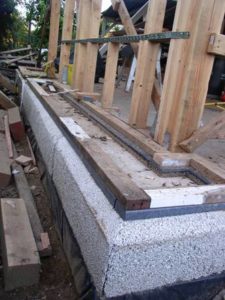Ensley Street Strawbale ADU
Case Study: Published | Updated: | | Tumwater, Washington |- Category
- category_listing(s)
- Building Type
- Residential
- Innovation
- Mixed Post and Beam/Strawbale Construction
- Jurisdiction
- Tumwater, Washington
- Parcel
- Officials
- John Darnall | City of Tumwater
- Team
-
John Darnall
|
approving-official
Jim Dawson | owner
builder
Shay Hohmann | contributor
Joseph Becker | contributor

This project was primarily challenging due to innovative insulation technique (straw bales); Tumwater and Thurston County jurisdictions were previously inexperienced with this type of engineering. Due to material choices based on ecologically based decision making, straw bale walls were approximately 2’ thick, this required extra discussion to verify footprint, whether to count sq ft from internal or external footprint of house—an important qualification to meet ADU permitting guidelines.
The Owner Builder/Designers worked closely with the City of Tumwater to ensure code compliance. This project was primarily challenging due to innovative insulation technique (straw bales) that city and county jurisdictions were previously inexperienced with. The California Energy Commission officially recognizes Straw bale construction using 3- string, 23” bales as having an insulation value of R-30. The thick walls required extra discussion to verify footprint and whether to count sq ft from internal or external footprint of house—an important qualification to meet ADU permitting guidelines.
Independent structural engineering was required, with additional review by a structural engineer on behalf of the jurisdiction.
| Code Requirement | Compliance Path |
|---|---|
| Structural: Lateral resistance
in Post and Beam construction |
Custom Engineering utilizing embedded sheer walls |
| WA State Energy Code | Effective default R-Value of 3 string straw bales
as provided by California Energy Commission |
| Vapor Retarder | Vapor Permeable wall system |
| Accessory Dwelling Unit (ADU)
Max footprint of 800 sq ft |
Extra discussion to verify footprint, whether to count
sq ft from internal or external footprint of house. |
| Code Requirement | Compliance Path |
|---|---|
| Structural: Lateral resistance
in Post and Beam construction |
Custom Engineering utilizing embedded sheer walls |
| WA State Energy Code | Effective default R-Value of 3 string straw bales
as provided by California Energy Commission |
| Vapor Retarder | Vapor Permeable wall system |
| Accessory Dwelling Unit (ADU)
Max footprint of 800 sq ft |
Extra discussion to verify footprint, whether to count
sq ft from internal or external footprint of house. |